Abstract
We propose a general model for neoplastic development which postulates that the loss of methyl groups from 5-methylcytosines (5-mC) involved in the control of gene expression may initiate neoplastic transformation and give rise to the aberrant phenotype of the transformed cell. Interference with normal patterns of methylation can be envisioned to occur by a number of mechanisms: as a result of carcinogen-induced G:C leads to A:T transition leading to a loss of potentially methylatable cytosines; by mutations or chromosome rearrangement which disrupt the integrity of active DNA methylase genes; by separating methylated repressor regions of the genome from the genes they control; by direct interference with DNA methylation, as proposed for ethionine and 5-azacytidine; by spontaneous deamination of 5-mC to thymine, leading to accumulation of 5-mC:G leads to T:A transitions, by virus-induced perturbations in host cell methylation patterns; and by activation of DNA demethylases.
Full text
PDF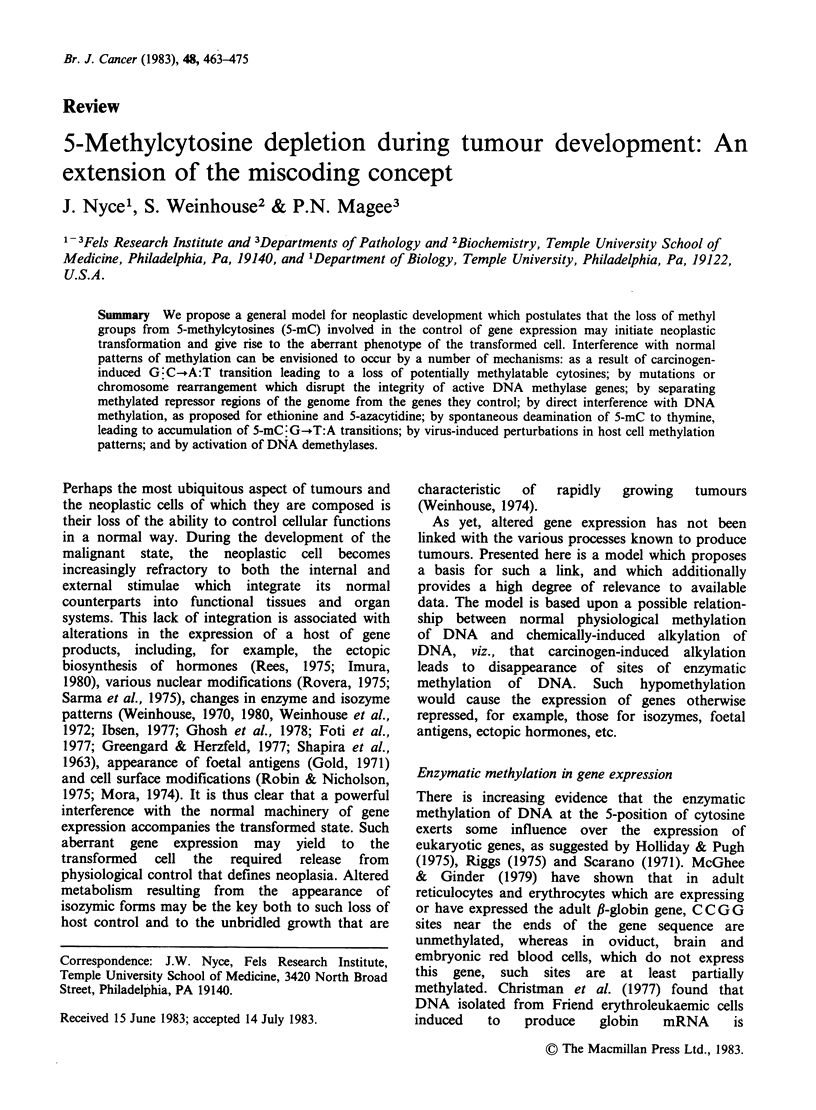
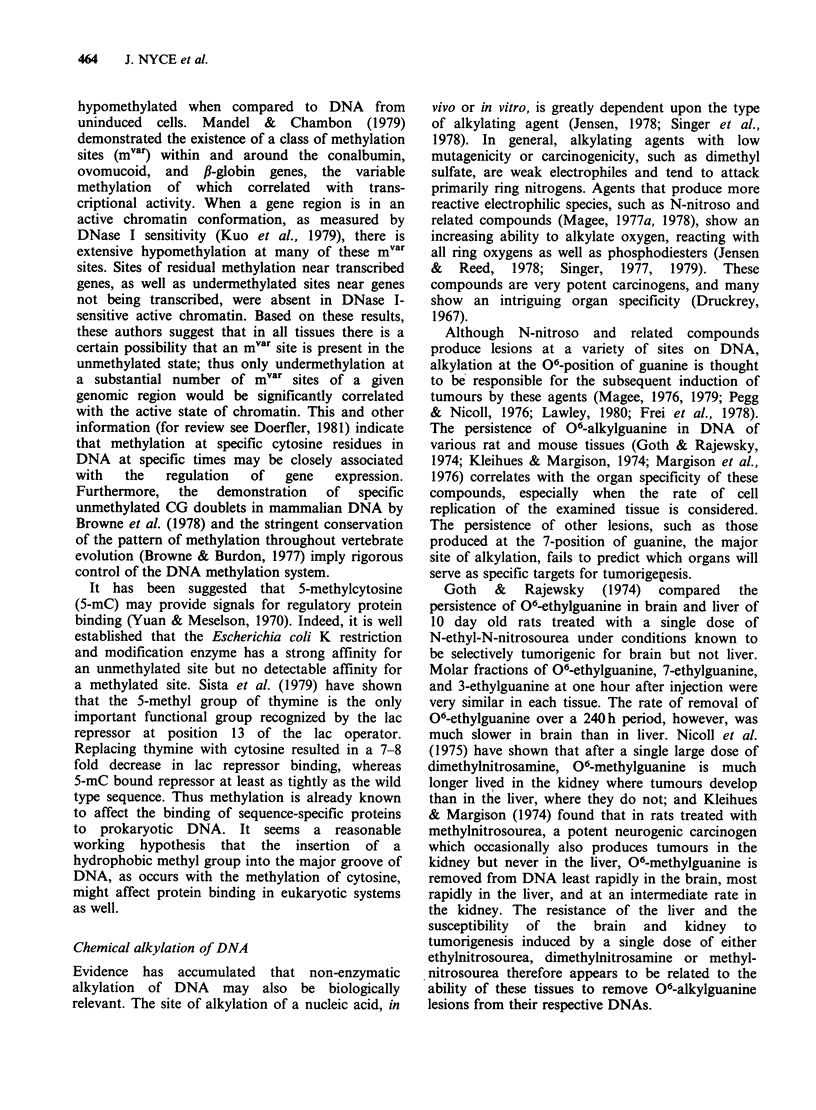

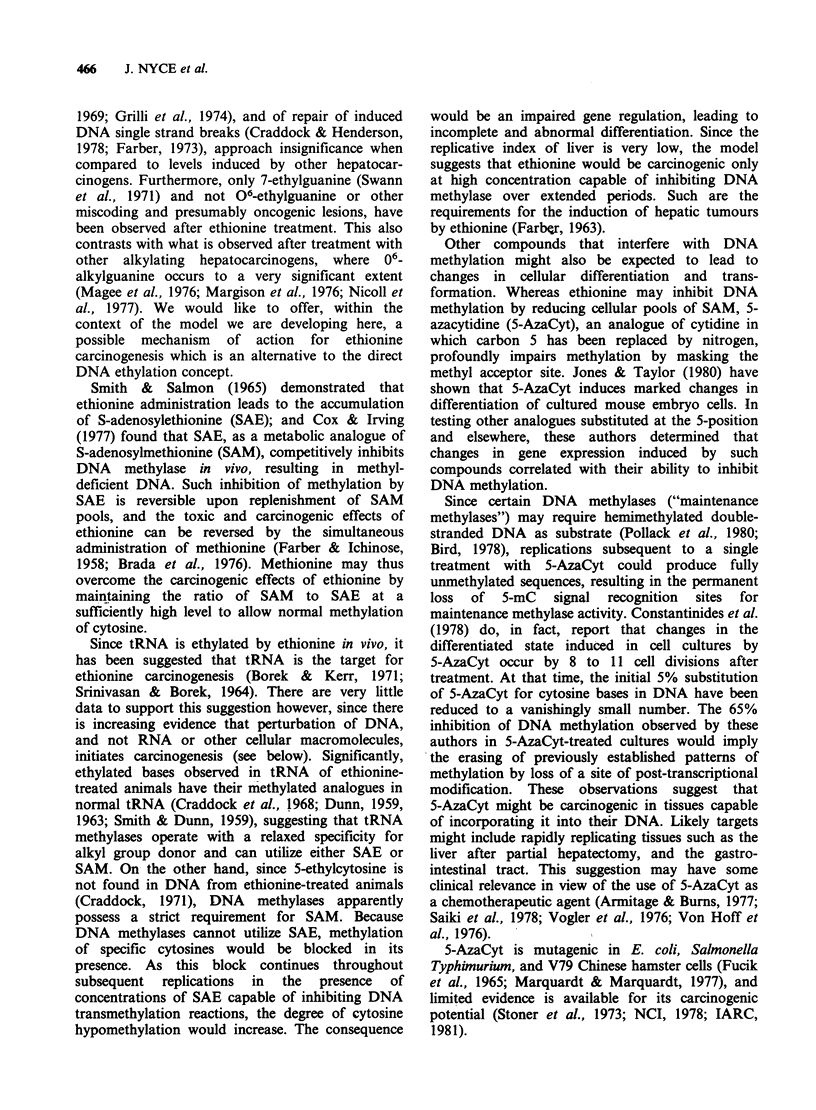

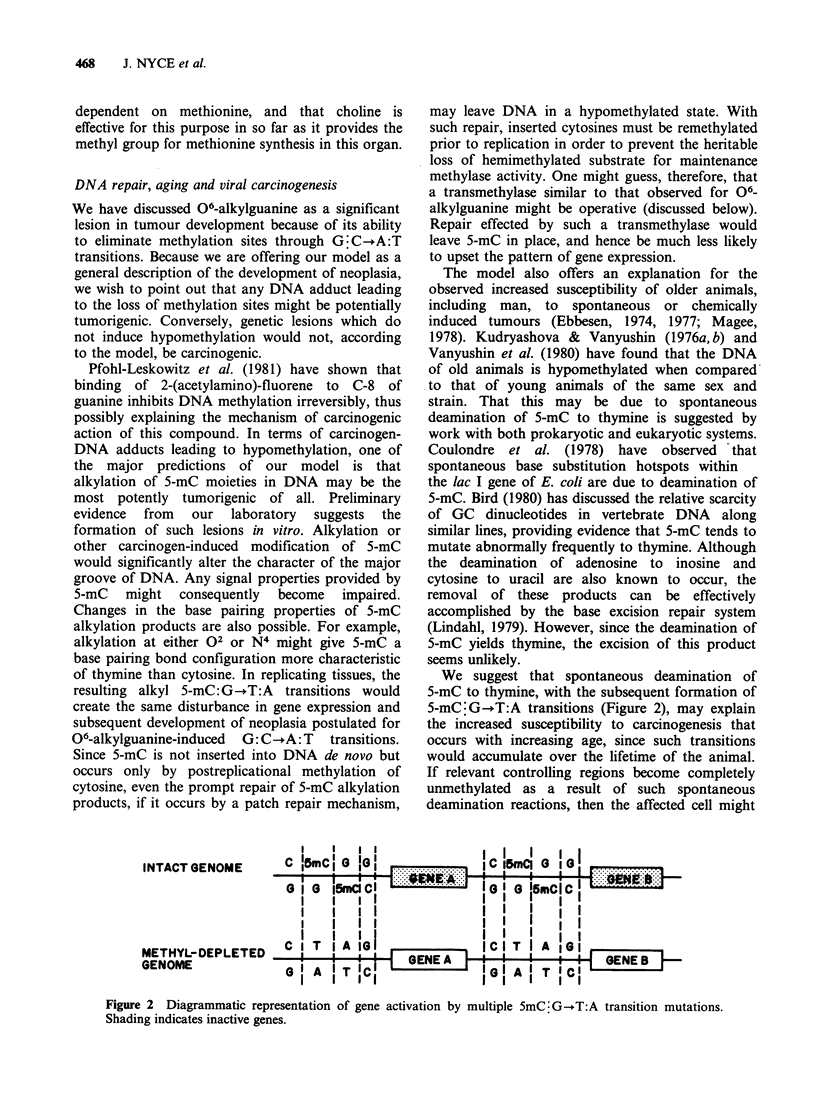
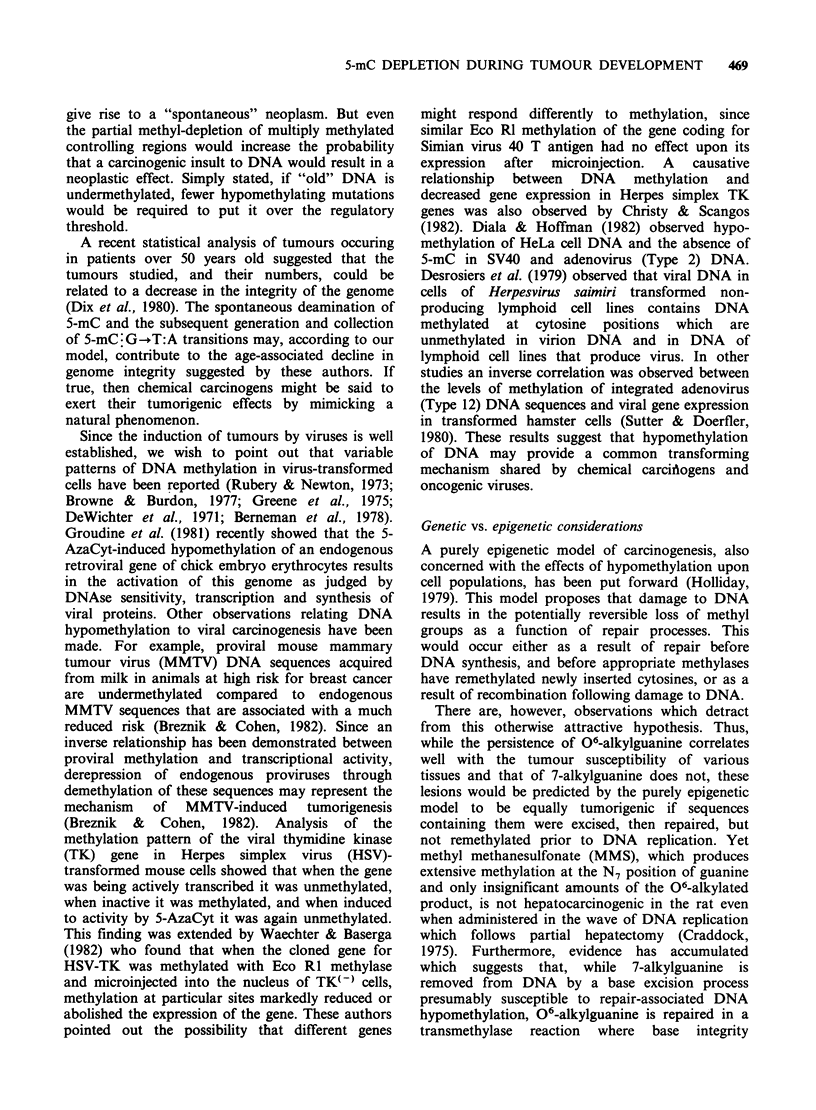

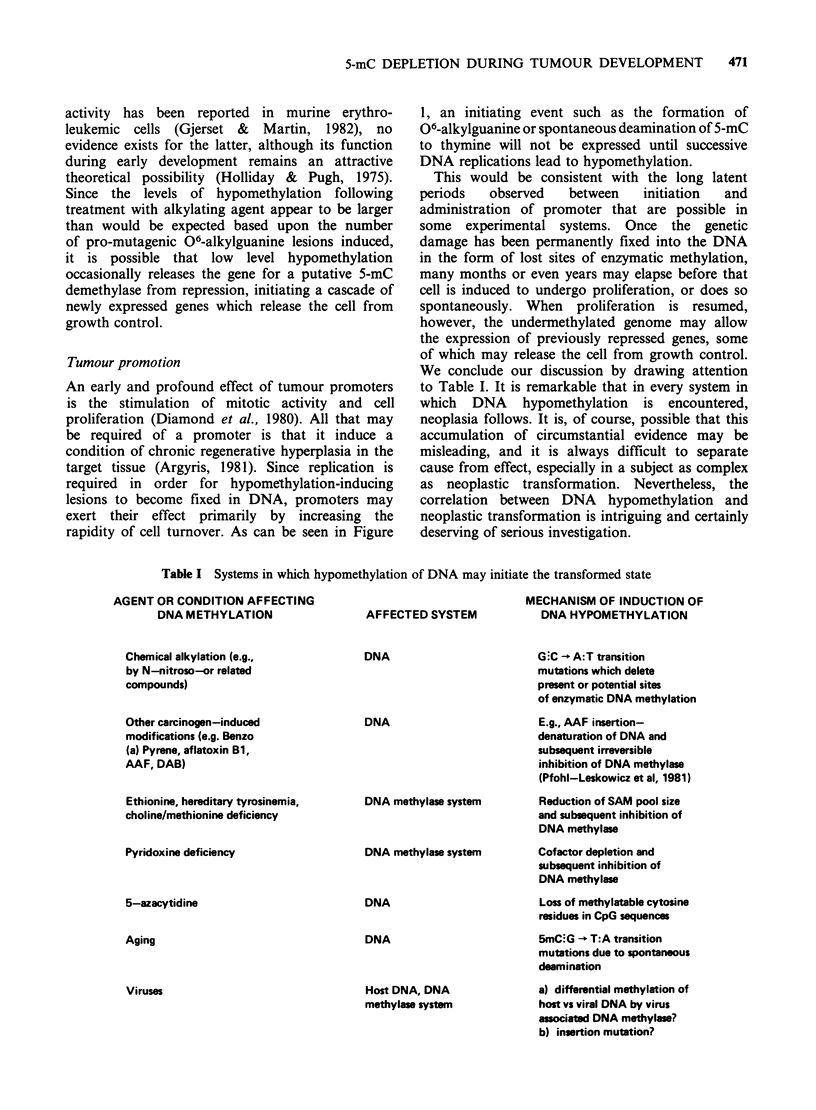




Selected References
These references are in PubMed. This may not be the complete list of references from this article.
- Argyris T. S. Tumor promotion by regenerative epidermal hyperplasia in mouse skin. J Cutan Pathol. 1982 Feb;9(1):1–18. doi: 10.1111/j.1600-0560.1982.tb01036.x. [DOI] [PubMed] [Google Scholar]
- Armitage J. O., Burns C. P. Treatment of refractory adult acute nonlymphoblastic leukemia with subcutaneous 5-azacytidine. Cancer Treat Rep. 1977 Dec;61(9):1721–1723. [PubMed] [Google Scholar]
- Barrett J. C., Tsutsui T., Ts'o P. O. Neoplastic transformation induced by a direct perturbation of DNA. Nature. 1978 Jul 20;274(5668):229–232. doi: 10.1038/274229a0. [DOI] [PubMed] [Google Scholar]
- Berneman A., Robert-Gero M., Vigier P. DNA methylase activity associated with Rous sarcoma virus. FEBS Lett. 1978 May 1;89(1):33–36. doi: 10.1016/0014-5793(78)80516-x. [DOI] [PubMed] [Google Scholar]
- Bird A. P. DNA methylation and the frequency of CpG in animal DNA. Nucleic Acids Res. 1980 Apr 11;8(7):1499–1504. doi: 10.1093/nar/8.7.1499. [DOI] [PMC free article] [PubMed] [Google Scholar]
- Bird A. P. Use of restriction enzymes to study eukaryotic DNA methylation: II. The symmetry of methylated sites supports semi-conservative copying of the methylation pattern. J Mol Biol. 1978 Jan 5;118(1):49–60. doi: 10.1016/0022-2836(78)90243-7. [DOI] [PubMed] [Google Scholar]
- Borek E., Kerr S. J. Atypical transfer RNA's and their origin in neoplastic cells. Adv Cancer Res. 1972;15:163–190. doi: 10.1016/s0065-230x(08)60374-7. [DOI] [PubMed] [Google Scholar]
- Breznik T., Cohen J. C. Altered methylation of endogenous viral promoter sequences during mammary carcinogenesis. Nature. 1982 Jan 21;295(5846):255–257. doi: 10.1038/295255a0. [DOI] [PubMed] [Google Scholar]
- Browne M. J., Burdon R. H. The sequence specificity of vertebrate DNA methylation. Nucleic Acids Res. 1977 Apr;4(4):1025–1037. doi: 10.1093/nar/4.4.1025. [DOI] [PMC free article] [PubMed] [Google Scholar]
- Browne M. J., Cato A. C., Burdon R. H. The distribution of modified and non-modified C-G doublets in BHK-21 cell DNA. FEBS Lett. 1978 Jul 1;91(1):69–73. doi: 10.1016/0014-5793(78)80019-2. [DOI] [PubMed] [Google Scholar]
- Bryngelsson T., Pero R. W. Purine base composition analysis of normal and tumor rat DNA. Chem Biol Interact. 1980 Mar;29(3):267–275. doi: 10.1016/0009-2797(80)90146-5. [DOI] [PubMed] [Google Scholar]
- Cairns J. The origin of human cancers. Nature. 1981 Jan 29;289(5796):353–357. doi: 10.1038/289353a0. [DOI] [PubMed] [Google Scholar]
- Christman J. K., Price P., Pedrinan L., Acs G. Correlation between hypomethylation of DNA and expression of globin genes in Friend erythroleukemia cells. Eur J Biochem. 1977 Nov 15;81(1):53–61. doi: 10.1111/j.1432-1033.1977.tb11926.x. [DOI] [PubMed] [Google Scholar]
- Christy B., Scangos G. Expression of transferred thymidine kinase genes is controlled by methylation. Proc Natl Acad Sci U S A. 1982 Oct;79(20):6299–6303. doi: 10.1073/pnas.79.20.6299. [DOI] [PMC free article] [PubMed] [Google Scholar]
- Constantinides P. G., Taylor S. M., Jones P. A. Phenotypic conversion of cultured mouse embryo cells by aza pyrimidine nucleosides. Dev Biol. 1978 Sep;66(1):57–71. doi: 10.1016/0012-1606(78)90273-7. [DOI] [PubMed] [Google Scholar]
- Coulondre C., Miller J. H., Farabaugh P. J., Gilbert W. Molecular basis of base substitution hotspots in Escherichia coli. Nature. 1978 Aug 24;274(5673):775–780. doi: 10.1038/274775a0. [DOI] [PubMed] [Google Scholar]
- Cox R., Irving C. C. Inhibition of DNA methylation by S-adenosylethionine with the production of methyl-deficient DNA in regenerating rat liver. Cancer Res. 1977 Jan;37(1):222–225. [PubMed] [Google Scholar]
- Craddock V. M. Effect of a single treatment with the alkylating carcinogens dimethynitrosamine, diethylnitrosamine and methyl methanesulphonate, on liver regenerating after partial hepatectomy. I. Test for induction of liver carcinomas. Chem Biol Interact. 1975 May;10(5):313–321. doi: 10.1016/0009-2797(75)90052-6. [DOI] [PubMed] [Google Scholar]
- Craddock V. M., Henderson A. R. De novo and repair replication of DNA in liver of carcinogen-treated animals. Cancer Res. 1978 Jul;38(7):2135–2143. [PubMed] [Google Scholar]
- Craddock V. M. Methylation of transfer RNA and of ribosomal RNA in rat liver in the intact animal and the effect of carcinogens. Biochim Biophys Acta. 1969 Dec 16;195(2):351–369. doi: 10.1016/0005-2787(69)90642-x. [DOI] [PubMed] [Google Scholar]
- Craddock V. M., Villa-Trevino S., Magee P. N. Occurrence of 7-methylguanine in nucleic acids of rat liver. Biochem J. 1968 Mar;107(2):179–184. doi: 10.1042/bj1070179. [DOI] [PMC free article] [PubMed] [Google Scholar]
- DUNN D. B. Additional components in ribonucleic acid of rat-liver fractions. Biochim Biophys Acta. 1959 Jul;34:286–288. doi: 10.1016/0006-3002(59)90274-4. [DOI] [PubMed] [Google Scholar]
- Desrosiers R. C., Mulder C., Fleckenstein B. Methylation of Herpesvirus saimiri DNA in lymphoid tumor cell lines. Proc Natl Acad Sci U S A. 1979 Aug;76(8):3839–3843. doi: 10.1073/pnas.76.8.3839. [DOI] [PMC free article] [PubMed] [Google Scholar]
- Diala E. S., Hoffman R. M. Hypomethylation of HeLa cell DNA and the absence of 5-methylcytosine in SV40 and adenovirus (type 2) DNA: analysis by HPLC. Biochem Biophys Res Commun. 1982 Jul 16;107(1):19–26. doi: 10.1016/0006-291x(82)91663-1. [DOI] [PubMed] [Google Scholar]
- Dix D., Cohen P., Flannery J. On the role of aging in cancer incidence. J Theor Biol. 1980 Mar 7;83(1):163–173. doi: 10.1016/0022-5193(80)90377-x. [DOI] [PubMed] [Google Scholar]
- Doerfler W. DNA methylation--a regulatory signal in eukaryotic gene expression. J Gen Virol. 1981 Nov;57(Pt 1):1–20. doi: 10.1099/0022-1317-57-1-1. [DOI] [PubMed] [Google Scholar]
- Druckrey H., Preussmann R., Ivankovic S., Schmähl D. Organotrope carcinogene Wirkungen bei 65 verschiedenen N-Nitroso-Verbindungen an BD-Ratten. Z Krebsforsch. 1967;69(2):103–201. [PubMed] [Google Scholar]
- Ebbesen P. Aging increases susceptibility of mouse skin to DMBA carcinogenesis independent of general immune status. Science. 1974 Jan 18;183(4121):217–218. doi: 10.1126/science.183.4121.217. [DOI] [PubMed] [Google Scholar]
- Ebbesen P. Effect of age of non-skin tissues on susceptibility of skin grafts to 7,12-dimethylbenz[alpha]anthracene (DMBA) carcinogenesis in BALB/c mice, and effect of age of skin graft on susceptibility of surrounding recipient skin to DMBA. J Natl Cancer Inst. 1977 Apr;58(4):1057–1060. doi: 10.1093/jnci/58.4.1057. [DOI] [PubMed] [Google Scholar]
- FARBER E., ICHINOSE H. The prevention of ethionine-induced carcinoma of the liver in rats by methionine. Cancer Res. 1958 Nov;18(10):1209–1213. [PubMed] [Google Scholar]
- Farber E. Carcinogenesis--cellular evolution as a unifying thread: Presidential address. Cancer Res. 1973 Nov;33(11):2537–2550. [PubMed] [Google Scholar]
- Felton J. S., Nebert D. W. Mutagenesis of certain activated carcinogens in vitro associated with genetically mediated increases in monooxygenase activity and cytochrome P 1-450. J Biol Chem. 1975 Sep 10;250(17):6769–6778. [PubMed] [Google Scholar]
- Forrester P. I., Hancock R. L. Theoretical mechanisms for synthesis of carcinogen-induced embryonic proteins. I. Alpha-fetoprotein induction by ethionine. Med Hypotheses. 1978 Jan-Feb;4(1):31–36. doi: 10.1016/0306-9877(78)90024-5. [DOI] [PubMed] [Google Scholar]
- Foti A. G., Herschman H., Cooper J. F. Isozymes of acid phosphatase in normal and cancerous human prostatic tissue. Cancer Res. 1977 Nov;37(11):4120–4124. [PubMed] [Google Scholar]
- Foy H., Kondi A., Davies J. N., Anderson B., Parker A., Preston J., Peers F. G. Histologic changes in livers of pyridoxine-deprived baboons--relation to alpha1 fetoprotein and liver cancer in Africa. J Natl Cancer Inst. 1974 Nov;53(5):1295–1311. doi: 10.1093/jnci/53.5.1295. [DOI] [PubMed] [Google Scholar]
- Frei J. V., Swenson D. H., Warren W., Lawley P. D. Alkylation of deoxyribonucleic acid in vivo in various organs of C57BL mice by the carcinogens N-methyl-N-nitrosourea, N-ethyl-N-nitrosourea and ethyl methanesulphonate in relation to induction of thymic lymphoma. Some applications of high-pressure liquid chromatography. Biochem J. 1978 Sep 15;174(3):1031–1044. doi: 10.1042/bj1741031. [DOI] [PMC free article] [PubMed] [Google Scholar]
- Gaull G. E., Rassin D. K., Solomon G. E., Harris R. C., Sturman J. A. Biochemical observations on so-called hereditary tyrosinemia. Pediatr Res. 1970 Jul;4(4):337–344. doi: 10.1203/00006450-197007000-00004. [DOI] [PubMed] [Google Scholar]
- Gerchman L. L., Ludlum D. B. The properties of O 6 -methylguanine in templates for RNA polymerase. Biochim Biophys Acta. 1973 May 10;308(2):310–316. doi: 10.1016/0005-2787(73)90160-3. [DOI] [PubMed] [Google Scholar]
- Ghosh B. C., Ghosh L., Newson B. L., Das Gupta T. K. Histochemical and ultrastructural study of lactic dehydrogenase in chemically induced lung cancer. Cancer Res. 1978 Sep;38(9):2790–2794. [PubMed] [Google Scholar]
- Goth R., Rajewsky M. F. Molecular and cellular mechanisms associated with pulse-carcinogenesis in the rat nerbous system by ethyinitrosourea: ethylation of nucleic acids and elimination rates of ethylated bases from the DNA of different tissues. Z Krebsforsch Klin Onkol Cancer Res Clin Oncol. 1974;82(1):37–64. doi: 10.1007/BF00304382. [DOI] [PubMed] [Google Scholar]
- Gould M. N., Jirtle R., Crowley J., Clifton K. H. Reevaluation of the number of cells involved in the neutron induction of mammary neoplasms. Cancer Res. 1978 Jan;38(1):189–192. [PubMed] [Google Scholar]
- Greene P. H., Poonian M. S., Nussbaum A. L., Tobias L., Garfin D. E., Boyer H. W., Goodman H. M. Restriction and modification of a self-complementary octanucleotide containing the EcoRI substrate. J Mol Biol. 1975 Dec 5;99(2):237–261. doi: 10.1016/s0022-2836(75)80143-4. [DOI] [PubMed] [Google Scholar]
- Greengard O., Herzfeld A. The undifferentiated enzymic composition of human fetal lung and pulmonary tumors. Cancer Res. 1977 Mar;37(3):884–891. [PubMed] [Google Scholar]
- Grilli S., Ferreri A. M., Rocchi P., Prodi G. In vivo and in vitro binding of ethionine with nucleic acids. Gan. 1974 Dec;65(6):507–511. [PubMed] [Google Scholar]
- Groudine M., Eisenman R., Weintraub H. Chromatin structure of endogenous retroviral genes and activation by an inhibitor of DNA methylation. Nature. 1981 Jul 23;292(5821):311–317. doi: 10.1038/292311a0. [DOI] [PubMed] [Google Scholar]
- Hayward W. S., Neel B. G., Astrin S. M. Activation of a cellular onc gene by promoter insertion in ALV-induced lymphoid leukosis. Nature. 1981 Apr 9;290(5806):475–480. doi: 10.1038/290475a0. [DOI] [PubMed] [Google Scholar]
- Holliday R. A new theory of carcinogenesis. Br J Cancer. 1979 Oct;40(4):513–522. doi: 10.1038/bjc.1979.216. [DOI] [PMC free article] [PubMed] [Google Scholar]
- Holliday R., Pugh J. E. DNA modification mechanisms and gene activity during development. Science. 1975 Jan 24;187(4173):226–232. [PubMed] [Google Scholar]
- Ibsen K. H. Interrelationships and functions of the pyruvate kinase isozymes and their variant forms: a review. Cancer Res. 1977 Feb;37(2):341–353. [PubMed] [Google Scholar]
- Imura H. Ectopic hormone production viewed as an abnormality in regulation of gene expression. Adv Cancer Res. 1980;33:39–75. doi: 10.1016/s0065-230x(08)60668-5. [DOI] [PubMed] [Google Scholar]
- Jensen D. E. Reaction of DNA with alkylating agents. Differential alkylation of poly[dA-dT[ by methylnitrosourea and ethylnitrosourea. Biochemistry. 1978 Nov 28;17(24):5108–5113. doi: 10.1021/bi00617a006. [DOI] [PubMed] [Google Scholar]
- Jensen D. E., Reed D. J. Reaction of DNA with alkylating agents. Quantitation of alkylation by ethylnitrosourea of oxygen and nitrogen sites on poly[dA-dT] including phosphotriester formation. Biochemistry. 1978 Nov 28;17(24):5098–5107. doi: 10.1021/bi00617a005. [DOI] [PubMed] [Google Scholar]
- Jones P. A., Taylor S. M. Cellular differentiation, cytidine analogs and DNA methylation. Cell. 1980 May;20(1):85–93. doi: 10.1016/0092-8674(80)90237-8. [DOI] [PubMed] [Google Scholar]
- Kastan M. B., Gowans B. J., Lieberman M. W. Methylation of deoxycytidine incorporated by excision-repair synthesis of DNA. Cell. 1982 Sep;30(2):509–516. doi: 10.1016/0092-8674(82)90248-3. [DOI] [PubMed] [Google Scholar]
- Kleihues P., Margison G. P. Carcinogenicity of N-methyl-N-nitrosourea: possible role of excision repair of O6-methylguanine from DNA. J Natl Cancer Inst. 1974 Dec;53(6):1839–1841. [PubMed] [Google Scholar]
- Kudriashova I. B., Vaniushin B. F. Metilirovanie iadernoi DNK pecheni krysy pri induktsii gidokortizonom. Biokhimiia. 1976 Feb;41(2):215–222. [PubMed] [Google Scholar]
- Kudriashova I. B., Vaniushin B. F. Metilirovanie in vitro iadernoi DNK iz raznykh organov krysy: Tkanevye i vozrastnye razlichiia aktseptornoi sposobnosti DNK. Biokhimiia. 1976 Jul;41(6):1106–1115. [PubMed] [Google Scholar]
- Kuo M. T., Mandel J. L., Chambon P. DNA methylation: correlation with DNase I sensitivity of chicken ovalbumin and conalbumin chromatin. Nucleic Acids Res. 1979 Dec 20;7(8):2105–2113. doi: 10.1093/nar/7.8.2105. [DOI] [PMC free article] [PubMed] [Google Scholar]
- Lapeyre J. N., Becker F. F. 5-Methylcytosine content of nuclear DNA during chemical hepatocarcinogenesis and in carcinomas which result. Biochem Biophys Res Commun. 1979 Apr 13;87(3):698–705. doi: 10.1016/0006-291x(79)92015-1. [DOI] [PubMed] [Google Scholar]
- Lawley P. D. DNA as a target of alkylating carcinogens. Br Med Bull. 1980 Jan;36(1):19–24. doi: 10.1093/oxfordjournals.bmb.a071608. [DOI] [PubMed] [Google Scholar]
- Liau M. C., Chang C. F., Belanger L., Grenier A. Correlation of isozyme patterns of S-adenosylmethionine synthetase with fetal stages and pathological states of the liver. Cancer Res. 1979 Jan;39(1):162–169. [PubMed] [Google Scholar]
- Lindahl T. DNA glycosylases, endonucleases for apurinic/apyrimidinic sites, and base excision-repair. Prog Nucleic Acid Res Mol Biol. 1979;22:135–192. doi: 10.1016/s0079-6603(08)60800-4. [DOI] [PubMed] [Google Scholar]
- Loveless A. Possible relevance of O-6 alkylation of deoxyguanosine to the mutagenicity and carcinogenicity of nitrosamines and nitrosamides. Nature. 1969 Jul 12;223(5202):206–207. doi: 10.1038/223206a0. [DOI] [PubMed] [Google Scholar]
- Magee P. N. The role of the liver in chemical carcinogenesis. Panminerva Med. 1976 Nov-Dec;18(11-12):427–432. [PubMed] [Google Scholar]
- Mandel J. L., Chambon P. DNA methylation: organ specific variations in the methylation pattern within and around ovalbumin and other chicken genes. Nucleic Acids Res. 1979 Dec 20;7(8):2081–2103. doi: 10.1093/nar/7.8.2081. [DOI] [PMC free article] [PubMed] [Google Scholar]
- Margison G. P., Margison J. M., Montesano R. Methylated purines in the deoxyribonucleic acid of various Syrian-golden-hamster tissues after administration of a hepatocarcinogenic dose of dimethylnitrosamine. Biochem J. 1976 Sep 1;157(3):627–634. doi: 10.1042/bj1570627. [DOI] [PMC free article] [PubMed] [Google Scholar]
- Marquardt H., Marquardt H. Induction of malignant transformation and mutagenesis in cell cultures by cancer chemotherapeutic agents. Cancer. 1977 Oct;40(4 Suppl):1930–1934. doi: 10.1002/1097-0142(197710)40:4+<1930::aid-cncr2820400826>3.0.co;2-8. [DOI] [PubMed] [Google Scholar]
- McCann J., Choi E., Yamasaki E., Ames B. N. Detection of carcinogens as mutagens in the Salmonella/microsome test: assay of 300 chemicals. Proc Natl Acad Sci U S A. 1975 Dec;72(12):5135–5139. doi: 10.1073/pnas.72.12.5135. [DOI] [PMC free article] [PubMed] [Google Scholar]
- McGhee J. D., Ginder G. D. Specific DNA methylation sites in the vicinity of the chicken beta-globin genes. Nature. 1979 Aug 2;280(5721):419–420. doi: 10.1038/280419a0. [DOI] [PubMed] [Google Scholar]
- Mortelmans K., Friedberg E. C., Slor H., Thomas G., Cleaver J. E. Defective thymine dimer excision by cell-free extracts of xeroderma pigmentosum cells. Proc Natl Acad Sci U S A. 1976 Aug;73(8):2757–2761. doi: 10.1073/pnas.73.8.2757. [DOI] [PMC free article] [PubMed] [Google Scholar]
- Nicoll J. W., Swann P. F., Pegg A. E. Effect of dimethylnitrosamine on persistence of methylated guanines in rat liver and kidney DNA. Nature. 1975 Mar 20;254(5497):261–262. doi: 10.1038/254261a0. [DOI] [PubMed] [Google Scholar]
- Nicoll J. W., Swann P. F., Pegg A. E. The accumulation of O6-methylguanine in the liver and kidney DNA of rats treated with dimethylinitrosamine for a short or a long period. Chem Biol Interact. 1977 Mar;16(3):301–308. doi: 10.1016/0009-2797(77)90109-0. [DOI] [PubMed] [Google Scholar]
- Olsson M., Lindahl T. Repair of alkylated DNA in Escherichia coli. Methyl group transfer from O6-methylguanine to a protein cysteine residue. J Biol Chem. 1980 Nov 25;255(22):10569–10571. [PubMed] [Google Scholar]
- Ortwerth B. J., Novelli G. D. Studies on the incorporation of L-ethionine-ethyl-l-14C into the transfer RNA of rat liver. Cancer Res. 1969 Feb;29(2):380–390. [PubMed] [Google Scholar]
- Pegg A. E., Roberfroid M., von Bahr C., Foote R. S., Mitra S., Bresil H., Likhachev A., Montesano R. Removal of O6-methylguanine from DNA by human liver fractions. Proc Natl Acad Sci U S A. 1982 Sep;79(17):5162–5165. doi: 10.1073/pnas.79.17.5162. [DOI] [PMC free article] [PubMed] [Google Scholar]
- Pfohl-Leszkowicz A., Salas C., Fuchs R. P., Dirheimer G. Mechanism of inhibition of enzymatic deoxyribonucleic acid methylation by 2-(acetylamino)fluorene bound to deoxyribonucleic acid. Biochemistry. 1981 May 26;20(11):3020–3024. doi: 10.1021/bi00514a005. [DOI] [PubMed] [Google Scholar]
- Poirier L. A., Grantham P. H., Rogers A. E. The effects of a marginally lipotrope-deficient diet on the hepatic levels of S-adenosylmethionine and on the urinary metabolites of 2-acetylaminofluorene in rats. Cancer Res. 1977 Mar;37(3):744–748. [PubMed] [Google Scholar]
- Pollack Y., Stein R., Razin A., Cedar H. Methylation of foreign DNA sequences in eukaryotic cells. Proc Natl Acad Sci U S A. 1980 Nov;77(11):6463–6467. doi: 10.1073/pnas.77.11.6463. [DOI] [PMC free article] [PubMed] [Google Scholar]
- Rees L. H. The biosynthesis of hormones by non-endocrine tumours--a review. J Endocrinol. 1975 Oct;67(1):143–175. doi: 10.1677/joe.0.0670143. [DOI] [PubMed] [Google Scholar]
- Regan J. D., Setlow R. B. Two forms of repair in the DNA of human cells damaged by chemical carcinogens and mutagens. Cancer Res. 1974 Dec;34(12):3318–3325. [PubMed] [Google Scholar]
- Renard A., Lemaitre M., Verly W. G. Repair of O6-alkylguanine lesions in DNA by chromatin enzymes. Biochimie. 1982 Aug-Sep;64(8-9):803–804. doi: 10.1016/s0300-9084(82)80132-6. [DOI] [PubMed] [Google Scholar]
- Riggs A. D. X inactivation, differentiation, and DNA methylation. Cytogenet Cell Genet. 1975;14(1):9–25. doi: 10.1159/000130315. [DOI] [PubMed] [Google Scholar]
- Rubery E. D., Newton A. A. DNA methylation in normal and tumour virus-transformed cells in tissue culture. I. The level of DNA methylation in BHK21 cells and in BHK21 cells transformed by polyoma virus (PyY cells). Biochim Biophys Acta. 1973 Sep 28;324(1):24–36. doi: 10.1016/0005-2787(73)90247-5. [DOI] [PubMed] [Google Scholar]
- SCHAPIRA F., DREYFUS J. C., SCHAPIRA G. ANOMALY OF ALDOLASE IN PRIMARY LIVER CANCER. Nature. 1963 Dec 7;200:995–997. doi: 10.1038/200995a0. [DOI] [PubMed] [Google Scholar]
- SMITH J. D., DUNN D. B. The occurrence of methylated guanines in ribonucleic acids from several sources. Biochem J. 1959 Jun;72(2):294–301. doi: 10.1042/bj0720294. [DOI] [PMC free article] [PubMed] [Google Scholar]
- SRINIVASAN P. R., BOREK E. ENZYMATIC ALTERATION OF NUCLEIC ACID STRUCTURE. Science. 1964 Aug 7;145(3632):548–553. doi: 10.1126/science.145.3632.548. [DOI] [PubMed] [Google Scholar]
- STEKOL J. A. BIOCHEMICAL BASIS FOR ETHIONINE EFFECTS ON TISSUES. Adv Enzymol Relat Areas Mol Biol. 1963;25:369–393. doi: 10.1002/9780470122709.ch7. [DOI] [PubMed] [Google Scholar]
- Scarano E. The control of gene function in cell differentiation and in embryogenesis. Adv Cytopharmacol. 1971 May;1:13–24. [PubMed] [Google Scholar]
- Singer B., Bodell W. J., Cleaver J. E., Thomas G. H., Rajewsky M. F., Thon W. Oxygens in DNA are main targets for ethylnitrosourea in normal and xeroderma pigmentosum fibroblasts and fetal rat brain cells. Nature. 1978 Nov 2;276(5683):85–88. doi: 10.1038/276085a0. [DOI] [PubMed] [Google Scholar]
- Singer B. N-nitroso alkylating agents: formation and persistence of alkyl derivatives in mammalian nucleic acids as contributing factors in carcinogenesis. J Natl Cancer Inst. 1979 Jun;62(6):1329–1339. [PubMed] [Google Scholar]
- Singer B. Sites in nucleic acids reacting with alkylating agents of differing carcinogenicity of mutagenicity. J Toxicol Environ Health. 1977 Jul;2(6):1279–1295. doi: 10.1080/15287397709529530. [DOI] [PubMed] [Google Scholar]
- Sista H. S., Loder R. T., Caruthers M. H. Studies on gene control regions X. The effect of specific adenine-thymine transversions on the lac repressor-lac operator interaction. Nucleic Acids Res. 1979 Jun 11;6(7):2583–2599. doi: 10.1093/nar/6.7.2583. [DOI] [PMC free article] [PubMed] [Google Scholar]
- Smith R. C., Salmon W. D. Formation of S-adenosylethionine by ethionine-treated rats. Arch Biochem Biophys. 1965 Jul;111(1):191–196. doi: 10.1016/0003-9861(65)90339-5. [DOI] [PubMed] [Google Scholar]
- Stoner G. D., Shimkin M. B., Kniazeff A. J., Weisburger J. H., Weisburger E. K., Gori G. B. Test for carcinogenicity of food additives and chemotherapeutic agents by the pulmonary tumor response in strain A mice. Cancer Res. 1973 Dec;33(12):3069–3085. [PubMed] [Google Scholar]
- Sutter D., Doerfler W. Methylation of integrated adenovirus type 12 DNA sequences in transformed cells is inversely correlated with viral gene expression. Proc Natl Acad Sci U S A. 1980 Jan;77(1):253–256. doi: 10.1073/pnas.77.1.253. [DOI] [PMC free article] [PubMed] [Google Scholar]
- Swann P. F., Pegg A. E., Hawks A., Farber E., Magee P. N. Evidence for ethylation of rat liver deoxyribonucleic acid after administration of ethionine. Biochem J. 1971 Jun;123(2):175–181. doi: 10.1042/bj1230175. [DOI] [PMC free article] [PubMed] [Google Scholar]
- Takebe H., Miki Y., Kozuka T., Furuyama J. I., Tanaka K. DNA repair characteristics and skin cancers of xeroderma pigmentosum patients in Japan. Cancer Res. 1977 Feb;37(2):490–495. [PubMed] [Google Scholar]
- Vogler W. R., Miller D. S., Keller J. W. 5-Azacytidine (NSC 102816): a new drug for the treatment of myeloblastic leukemia. Blood. 1976 Sep;48(3):331–337. [PubMed] [Google Scholar]
- Von Hoff D. D., Slavik M., Muggia F. M. 5-Azacytidine. A new anticancer drug with effectiveness in acute myelogenous leukemia. Ann Intern Med. 1976 Aug;85(2):237–245. doi: 10.7326/0003-4819-85-2-237. [DOI] [PubMed] [Google Scholar]
- Waechter D. E., Baserga R. Effect of methylation on expression of microinjected genes. Proc Natl Acad Sci U S A. 1982 Feb;79(4):1106–1110. doi: 10.1073/pnas.79.4.1106. [DOI] [PMC free article] [PubMed] [Google Scholar]
- Waldstein E. A., Cao E. H., Setlow R. B. Adaptive resynthesis of O6-methylguanine-accepting protein can explain the differences between mammalian cells proficient and deficient in methyl excision repair. Proc Natl Acad Sci U S A. 1982 Sep;79(17):5117–5121. doi: 10.1073/pnas.79.17.5117. [DOI] [PMC free article] [PubMed] [Google Scholar]
- Weinberg A. G., Mize C. E., Worthen H. G. The occurrence of hepatoma in the chronic form of hereditary tyrosinemia. J Pediatr. 1976 Mar;88(3):434–438. doi: 10.1016/s0022-3476(76)80259-4. [DOI] [PubMed] [Google Scholar]
- Weinberg R. A. Oncogenes of spontaneous and chemically induced tumors. Adv Cancer Res. 1982;36:149–163. doi: 10.1016/s0065-230x(08)60424-8. [DOI] [PubMed] [Google Scholar]
- Weinhouse S. New dimensions in the biology of cancer. Cancer. 1980 Jun 15;45(12):2975–2980. doi: 10.1002/1097-0142(19800615)45:12<2975::aid-cncr2820451215>3.0.co;2-f. [DOI] [PubMed] [Google Scholar]
- Yuan R., Meselson M. A specific complex between a restriction endonuclease and its DNA substrate. Proc Natl Acad Sci U S A. 1970 Feb;65(2):357–362. doi: 10.1073/pnas.65.2.357. [DOI] [PMC free article] [PubMed] [Google Scholar]
- de Wachter R., Merregaert J., Vandenberghe A., Contreras R., Fiers W. Studies on the bacteriophage MS2. The untranslated 5'-terminal nucleotide sequence preceding the first cistron. Eur J Biochem. 1971 Oct 14;22(3):400–414. doi: 10.1111/j.1432-1033.1971.tb01558.x. [DOI] [PubMed] [Google Scholar]


